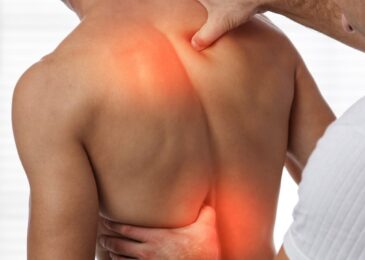
What causes these pains and how is it treated and avoided in the future? Follow this article:
Upper Back Pain and Nausea Reasons:
Upper Back Pain and Nausea�can be symptoms of osteoporosis, joint inflammation, bruising, fractures, and�deformities of the spine such as hemorrhoids and hemorrhages. It can occur over time due to�stress or sitting in wrong positions.
But the most important causes of these pains are muscle spasm and functional articular disorders.
Risk factors include advanced age, obesity, lack of physical activity, smoking, and mental�disorders such as anxiety and depression.
Upper Back Pain and Nausea Symptoms:
Upper back pain and nausea can characterize by a sharp stab that can spread to the lower extremities and neck. Because of its strength, muscle movement is very limited.
If this pain continues or is associated with numbness and numbness in the lower extremities or disturbances in the habit of defecation, consult your doctor immediately.
We will talk about muscle spasm and functional articular disorders in some detail because they are the most common causes of upper back pain and nausea.
Muscle cramps:
The shoulder strap of the shoulder blade and the posterior side of the rib cage are attached to largely sized muscles, which cause severe pain.
These convulsions are usually due to lack of muscle strength, or excessive muscular stress caused by repetitive movements.
Muscle tension, sports injuries and car accidents can also cause pain caused by muscle irritation.
This type of upper back pain and nausea are the most responsive to physical therapy – including muscle relaxation and strengthening exercises, active and passive physical therapy, chiropractic therapy, osteopathic manipulation, massage therapy and acupuncture.
If a specific area is very sensitive, the source of pain may be the active trigger point (usually located in the skeletal muscles); we can then resort to massage or acupuncture and injection of local anesthetic such as lidocaine at the trigger points.
Medication can use to relieve pain, including peripheral painkillers such as paracetamol and non-steroidal anti-inflammatory drugs such as Ibuprofen, muscle relaxants and three-loop antidepressants such as Amitriptyline.
If pain persists, central analgesics of morphine derivatives will use for a short period under the supervision of a physician.
Functional articular disorders, the second causes of Upper back pain and Nausea:
The ribs connect the vertebrae and the thoracic spine through joints on both sides.
These joints are vulnerable to injury due to erratic movements or positions, causing pain and discomfort. The methods of treatment here are not different from what we mentioned earlier.
Where Treatment of this type of injury involves physiotherapy with the help of orthopedic specialists to help move the joints; and a home exercise program to stretch and strengthen the spine and shoulders. Medicine treatment includes painkillers and non-steroidal anti-inflammatory pills.
Upper Back pain and Nausea and dizziness are just a few symptoms will cause by the presence of gravel in the body.
What is surprising is that although gravel is common among millions of people, whether or not it exists is not always properly can diagnose, simply because few general practitioners understand it.
Upper back pain and nausea are not common, such as lower back pain or neck pain, because the bones of this part of the back do not bend or move as do the bones in the lower back or neck, but instead work with the thoracic cage to maintain back stability.
To protect vital organs such as the heart and lungs.
Causes of upper back pain and Nausea:
- Increase the use of muscles or injury to muscles, ligaments, and discs that support the spine.
- The wrong situation.
- Pressure on the nerves of the spine due to certain problems such as disc herniation.
- Break one of the paragraphs.
- Osteoporosis resulting from damage to cartilage, which acts as a cushion for small joints in the spine.
- Fibro-muscular pain that affects the connective tissue of a muscle or group of muscles.
- In rare cases, pain could cause by other problems such as gallbladder disease, cancer or infection.
Upper back pain and Nausea�Symptoms:
- Feeling sharp pain, heartburn or heaviness in this area.
- Feeling tight and roughness in the muscles.
Some serious symptoms that need treatment immediately:
- Weakness in the arms and legs.
- numbness in the arms, legs, chest or abdomen.
- Lack of bowel or bladder controller.
How to diagnose upper back pain and nausea:
The doctor asks the patient first about his or her medical history, symptoms, work, daily activities, physical examination, and may require X-rays or MRIs to see if there is a bone fracture or disc herniation the pain.
How to treat upper back pain and nausea:
Symptoms of this pain could control if mild or moderate by:
- Drugs not prescribed medically, such as acetaminophen (atenolol for example), non-steroidal anti-inflammatory drugs (eg Advil, Alfa, aspirin, and Motrin).
- Hot or cold compresses.
- Exercise.
- Manual treatment such as massage, stirring, spinal processing.
However, if the pain persists and difficulty in doing the daily activities, the patient may need to visit the doctor to prescribe the appropriate medication, but this condition rarely needs surgery.
How to care for yourself at home from�upper back pain and nausea:
There are some ways to consider pain relief:
- Rest: If your back hurts a lot, you should take some rest, but you should not stay long without movement, you can go back to the daily activities slowly.
- The use of analgesic drugs: such as acetaminophen, anti-inflammatory drugs (aspirin, and Motrin), because it helps to relieve pain and tension, which is completely safe, but read the instructions attached to these drugs.
- Use of cool or hot dressings:�Hot packs to relieve pain and roughness, but the ice packs work to reduce pain and swelling.
- Exercise: The sport extends and strengthens the back muscles, shoulders, and stomach, and can help improve the session and reduce the risk of injuries and reduce pain.
- Incubator situation: You must stop straight without twisting.
- Learn some ways to relieve stress: You can experience deep breathing and exercise exercises meditation and relaxation.





